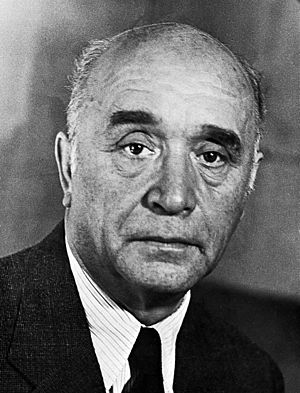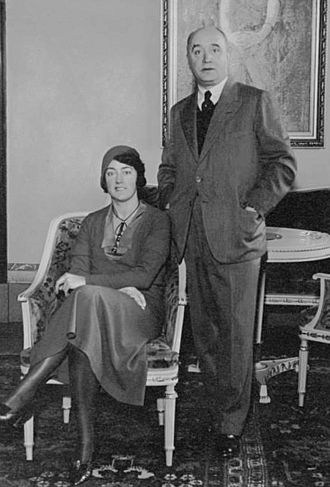Friedrich Bergius facts for kids
Quick facts for kids
Friedrich Karl Rudolf Bergius
|
|
|---|---|
 |
|
| Born | 11 October 1884 |
| Died | 30 March 1949 (aged 64) |
| Nationality | German |
| Alma mater | University of Breslau, University of Leipzig |
| Known for | Bergius process Hydrothermal carbonization |
| Awards | Nobel Prize for Chemistry (1931) Melchett Medal (1934) Wilhelm Exner Medal (1937) |
| Scientific career | |
| Fields | Chemistry |
| Institutions | Leibniz University Hannover |
| Doctoral advisor | Arthur Rudolf Hantzsch |
| Other academic advisors | Richard Abegg |
Friedrich Karl Rudolf Bergius (born October 11, 1884 – died March 30, 1949) was a German chemist. He is famous for creating a way to make synthetic fuel from coal. This method is known as the Bergius process. He also shared the Nobel Prize in Chemistry in 1931. He won this award for his important work on chemical methods using high pressure. After World War II, his citizenship was questioned. This led him to leave Germany and move to Argentina. There, he worked as an adviser for the Ministry of Industry. Bergius was born near Wrocław in what was then the German Empire.
Contents
Becoming a Chemist: Bergius's Early Studies
Before starting his chemistry studies, Friedrich Bergius gained practical experience. He worked for six months at a steel factory. In 1903, he began studying at the University of Breslau. He then moved to the University of Leipzig. By 1907, after only four years, he earned his PhD in chemistry. His main research focused on sulfuric acid.
In 1909, Bergius worked with two very famous chemists. They were Fritz Haber and Carl Bosch. They were developing the Haber-Bosch Process, which is very important for making fertilizers. Later, Bergius was invited to work at the Leibniz University Hannover. He worked with Max Bodenstein, who studied how fast chemical reactions happen.
Amazing Discoveries: Bergius's Key Work
Turning Coal into Fuel: The Bergius Process
Friedrich Bergius developed special ways to work with carbon-containing materials. He used very high pressures and temperatures. In 1913, he received a patent for his most famous invention, the Bergius process. This process turns lignite (brown coal) into liquid hydrocarbons. These liquids can be used as synthetic fuel. He developed this method before another well-known process, the Fischer–Tropsch process.
In 1914, he was invited to build a factory to use his process. Production started in 1919, after World War I ended. At first, there were many technical problems. Also, the economy was facing inflation. Another chemist, Franz Joseph Emil Fischer, often criticized his work. However, after seeing a demonstration, Fischer changed his mind and supported Bergius. The progress was slow, so Bergius sold his patent to BASF. There, Carl Bosch continued to improve the process. Before World War II, several factories were built. They could produce millions of tons of synthetic fuel each year.
Making Sugar from Wood: A Challenging Project
Bergius also worked on a difficult project: turning wood into sugar. This sugar could then be used by industries. After moving to Heidelberg, he worked hard to make this process better. He even planned to produce it on a large scale. However, the high costs and technical problems almost made him go bankrupt. It is said that a bailiff (someone who collects debts) followed him to Stockholm. This was to get the money from his Nobel Prize in Chemistry in 1931.
Before World War II, many countries wanted to be self-sufficient. This desire helped boost the wood-to-sugar process. Several plants were built. Bergius moved to Berlin, but he was not very involved in the later development. While he was away in Austria, his laboratory and home were destroyed by an airstrike. He stayed in Austria for the rest of the war.
Working Around the World: International Engagement
After the war, there were questions about Bergius's citizenship. Because of his past work, he decided to leave Germany. He worked as an adviser in several countries. These included Italy, Turkey, Switzerland, and Spain. Eventually, he moved to Argentina. There, he became an adviser to the Ministry of Industry. Friedrich Bergius passed away in Buenos Aires on March 30, 1949. He is buried in the German Cemetery there.
Awards and Recognition
Friedrich Bergius and Carl Bosch won the Nobel Prize in Chemistry in 1931. They received this award for their important work. They invented and developed chemical methods that use high pressure. In 1937, Bergius was also given the Wilhelm Exner Medal.
Family Life
Friedrich Bergius was the father of Renate Burgess.
See also
 In Spanish: Friedrich Bergius para niños
In Spanish: Friedrich Bergius para niños


